고급자를 위한 이슈영어
Indonesia tsunami: Palu hit by 'worst case scenario'
Author
에이플러스
Date
2018-10-02 18:55
Views
1785
Indonesia tsunami: Palu hit by 'worst case scenario'
인도네시아 쓰나미: Palu 지역이 최악의 시나리오에 당하다
By Anna Jones
BBC News

Indonesia experiences earthquakes every day, but the scale of the quake and tsunami which hit Palu on Friday took local people and scientists by surprise.
인도네시아는 항상 지진을 겪었습니다 하지만, 지난 금요일에 Palu지역을 덮친 지진과 쓰나미는 현지인들과 과학자들을 놀라게 하였습니다.
More than 1,000 people have died, but the final figure could be much higher, say officials.
1000명이상의 사람들이 사망하였지만 최종 집계는 더 많을 것이라고 정부 관료가 말했습니다.
As scientists explained to the BBC, a combination of geography, timing and inadequate warnings meant that what happened in Palu was a worst case scenario.
과학자들이 BBC에 설명했듯이, 지리, 타이밍, 부적절한 경고의 조합은 Palu 지역에서 일어난 일이 최악의 시나리오라는 것을 의미합니다.
A perilous location
위험한 장소
Earthquakes are caused by the Earth's tectonic plates sliding against or under each other. This is happening constantly, but sometimes the movement is big enough and closes enough to populated areas to have devastating consequences.
지진은 지구의 지각 판이 서로 미끄러지거나 아래로 미끄러지면서 발생합니다. 이런 현상은 끊임없이 일어나고 있지만, 때로는 그 움직임이 커서 인구밀도가 높은 지역에 엄청난 결과를 낳을 수 있습니다.
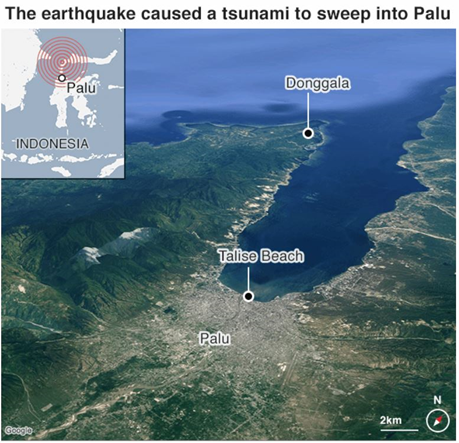
Small tremors had been happening throughout Friday in Palu, but in the early evening the Palu-Koru fault suddenly slipped, a short distance off shore and only 10km (6 miles) below the surface, generating a 7.5 magnitude quake.
Palu에서는 금요일 내내 약간의 진동이 있었지만, 이른 저녁에는 Palu-Koru 고리가 갑자기 미끄러져 해안에서 불과 10km(6마일) 떨어진 수면 아래로 떨어져 진도 7.5의 지진이 발생했습니다.
Hamza Latief, from the Bandung Institute of Technology, has been studying the fault line since 1995 and says the impact of the quake was magnified by the thick layers of sediment on which the city sits.
1995년부터 결함선을 연구해온 반둥 공과대학의 Hamza Latief는, 지진의 영향은 도시가 위치한 두꺼운 퇴적층들에 의해 확대되었다고 말했습니다.
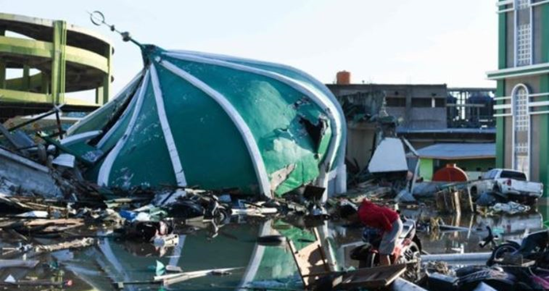
Whereas rock just shakes in a quake, sediment moves around a lot more, essentially behaving like liquid. Few poorly built properties can withstand such movement.
바위가 지진에 흔들리는 반면, 침전물은 본질적으로 액체처럼 행동하면서 훨씬 더 많이 움직입니다. 그러한 움직임을 견딜 수 있는 부실한 건물은 거의 없습니다.
"Any place where people have put buildings on fill - where they've dug dirt and moved it to another place - is not going to be as solid as bedrock," says Jess Phoenix, a US-based geologist who has studied Indonesia.
인도네시아를 연구해온 미국의 지질학자인 Jess Phoenix는 “사람들이 건물을 짓는 곳(흙을 파서 다른 곳으로 옮긴 곳)은 암초만큼 견고 하지 않다”라고 말했습니다.
When it comes to quakes, she says, "those are the areas to worry about".
지진에 관한 한, 그녀는 “그곳들은 걱정해야 할 장소들입니다”라고 말했습니다.
An unexpected wave
예측하지 못한 파도
"You don't normally pay much attention to the Palu-Koru fault line, as far as tsunamis are concerned," says Prof Philip Liu Li-Fan at the National University of Singapore.
싱가포르 국립대학의 Philip Liu Li-Fan 교수는 "해일 발생에 관한 한 일반적으로 Palu-Koru 단층선에 많은 주의를 기울이지 않는다"고 말했습니다.
That's because the two plates are moving horizontally, not with the vertical thrust usually required to set off dangerous waves.
그것은 두 판이 일반적으로 위험한 파도를 일으키는 수직 추력이 아닌 수평으로 움직이고 있기 때문입니다.
"We have been trying to figure out what was really going on," says Prof Liu.
"우리는 실제로 무슨 일이 일어나고 있는지 알아내려고 노력해왔습니다," 라고 류 교수가 말했습니다.
It could be that the quake kicked off a landslide underwater, which in turn disturbed the water, he says, or there could be inaccuracies in describing the fault, but "we don't really know yet".
그는 지진이 물 속에서 산사태를 일으켰을 수도 있고, 그 지진은 물을 교란시켰을 수도 있고, 단층선을 묘사할 때 부정확할 수도 있지만, "아직 우리는 잘 모른다"고 말했습니다.
But once the wave started moving, Palu - at the end of a narrow 10km-long bay, was a sitting duck.
그러나 파도가 밀려오기 시작하자, 10km 길이의 좁은 만 끝에 있는 Palu는 앉아있는 오리였습니다.
Within three minutes, Palu was hit by three waves.
3분안에 Palu는 세 개의 파도에 치였습니다.
Jess Phoenix said the geography and timing meant it was "basically a worst case scenario".
Jess Phoenix는 지리와 타이밍이 “기본적으로 최악의 시나리오”라는 것을 의미한다고 말했습니다.
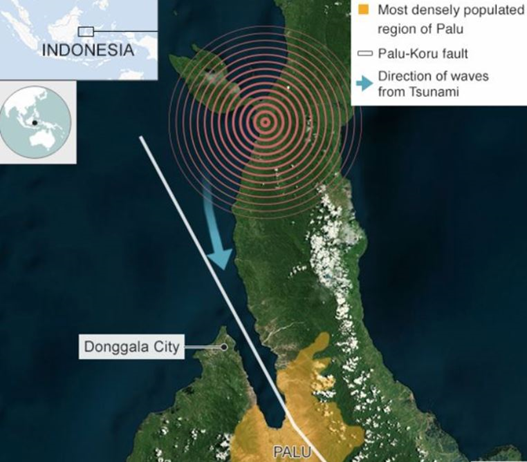
"When water comes into a horseshoe-shaped area like that, instead of the wave increasing just because the ocean is getting shallow, you also have the bowl effect, where the waves are going to reflect off the shoreline around it."
“말굽 모양의 지역에 물이 들어가면, 바다가 점점 얕아지고 있기 때문에 파도가 증가하는 대신에 파도가 해안가를 반사하는 보울 효과를 보게 됩니다”
Mr Latief says the area has been hit by tsunamis before. Historical records show that in 1927, one wave was 3-4m at the mouth of the bay but had risen to 8m by the time it reached the town.
Latief 씨는 그 지역이 전에 쓰나미에 의해 강타당했다고 말했습니다. 역사 기록에 따르면 1927년, 한 파도가 만 입구에서 3~4m였으나, 마을에 도달했을 때 8m까지 올라갔다고 합니다.
An ineffective warning system?
효과적인 경보 시스템?
After the 2004 Indian Ocean tsunami killed a quarter of a million people, huge amounts of money were spent on an early warning system.
2004년 인도양 쓰나미가 25만명의 목숨을 앗아간 후, 초기 경고시스템에 엄청난 금액의 돈이 소비되었습니다.
A complex system of sensors was installed across the region. These are meant to help scientists quickly assess whether a quake is likely to trigger a tsunami, and alert the public to move to higher ground.
그 지역에는 복잡한 센서 시스템이 설치되었습니다. 이것은 지진으로 인해 쓰나미가 발생할 가능성이 있는지 여부를 과학자들이 신속하게 평가하고 대중에게 더 높은 곳으로 이동하라고 경고하는 것을 돕기 위한 것입니다.
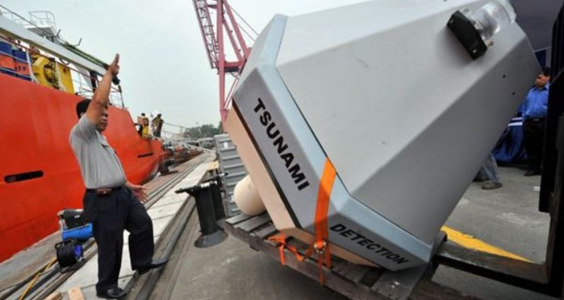
The head of Indonesia's disaster mitigation agency has said that a key part of the country's warning system - a series of buoys connected to seafloor sensors designed to detect tsunamis - had not been working since 2012. He blamed a lack of funding.
인도네시아 재난완화기구의 책임자는 쓰나미를 감지하기 위해 고안된 해저 센서와 연결된 일련의 부표인 경고 시스템의 핵심 부분이 2012년부터 작동하지 않고 있다고 말했습니다. 그는 자금 부족 탓을 비난했습니다.
Prof Liu says the system is "sort of working and sort of not working", and that Indonesia's focus has largely been its southern regions, which were so badly hit in 2004.
류 교수는 이 시스템이 "일하는 것 같으며 작동하지 않는 것"이라고 말하며, 인도네시아의 초점은 2004년에 크게 타격을 받은 남부 지역이었다고 말했습니다.
A tsunami warning was issued after the quake, but, says Jess Phoenix, "it'll be interesting to see what comes out about whether the warning was implemented correctly, whether people heard it".
지진 후에 쓰나미 경보가 발령되었지만, "그 경고가 제대로 전달되었는지, 사람들이 그것을 들었는지를 아는 것은 흥미로울 것입니다."라고 Jess Phoenix는 말했습니다.
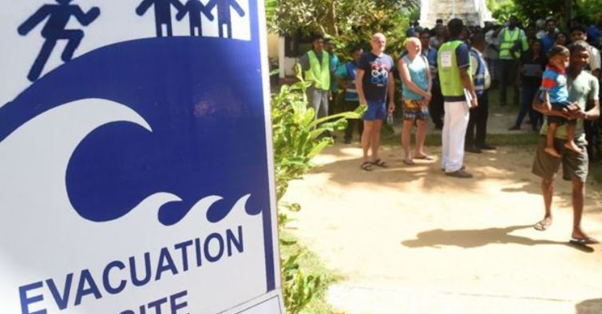
It's not unusual for people to be killed by a tsunami because they stayed to look at the spectacle of the sea suddenly drawing back as the wave builds up. Since 2004, a huge amount of effort has gone into educating people to run inland if the water retreats.
쓰나미에 의해 죽는 것은 드문 일이 아닙니다 왜냐하면 그들은 파도가 쌓이면서 갑자기 후퇴하는 바다의 광경을 보기 위해 머물렀기 때문입니다. 2004년 이후, 물이 빠지면 사람들이 내륙으로 대피하는 것을 교육하는 데 엄청난 노력을 기울였습니다.
One man told the BBC's Rebecca Henschke he saw the sea disappear and sent his family running to higher ground while he grabbed a nearby child and clung to a tree.|
한 남자는 BBC의 Rebecca Henschke에게, 근처의 아이를 붙잡고 나무에 매달려 있는 동안 바다가 사라지는 것을 보고 그의 가족들에게 높은 곳으로 대피하라고 보냈다고 말했습니다
But despite the warning, it appears there were still lots of people on or near the beach in Palu, many of them setting up for a festival.
하지만 경고에도 불구하고, Palu해변가 근처에는 많은 사람들이 있었고, 그들 중 많은 사람들이 축제 준비를 하고 있었습니다.
"People in that region are really familiar with what tsunami can do. I'm hopeful that if there were casualties on the beach they were trying to leave," said Ms Phoenix.
"이 지역의 사람들은 쓰나미가 무엇을 할 수 있는지 정말 잘 알고 있습니다. 만약 해변에서 사상자가 발생한다면, 그들이 떠나려고 했던 것이기를 바랍니다," 라고 피닉스 씨가 말했습니다.
"But a 10ft wave is really substantial. To get everyone evacuated in a very short amount of time you have to have very clear egress routes marked.”
"하지만 10피트 파도는 정말 상당한 크기입니다. 짧은 시간 안에 모든 사람들이 대피하도록 하려면 아주 분명한 대피 경로를 표시해야 합니다.”
"From my experience working in Indonesia, I didn't see super clearly marked egress routes. I'm not sure about that particular town, but it is really hard to get a large amount of people out of an area quickly."
"인도네시아에서 일한 경험으로 볼 때, 저는 확실히 표시된 대피로를 보지 못했습니다. 특정 도시에 대해서는 잘 모르겠지만, 그 지역에서 많은 사람을 빨리 구하는 것은 정말 어렵습니다."
인도네시아 쓰나미: Palu 지역이 최악의 시나리오에 당하다
By Anna Jones
BBC News

Indonesia experiences earthquakes every day, but the scale of the quake and tsunami which hit Palu on Friday took local people and scientists by surprise.
인도네시아는 항상 지진을 겪었습니다 하지만, 지난 금요일에 Palu지역을 덮친 지진과 쓰나미는 현지인들과 과학자들을 놀라게 하였습니다.
More than 1,000 people have died, but the final figure could be much higher, say officials.
1000명이상의 사람들이 사망하였지만 최종 집계는 더 많을 것이라고 정부 관료가 말했습니다.
As scientists explained to the BBC, a combination of geography, timing and inadequate warnings meant that what happened in Palu was a worst case scenario.
과학자들이 BBC에 설명했듯이, 지리, 타이밍, 부적절한 경고의 조합은 Palu 지역에서 일어난 일이 최악의 시나리오라는 것을 의미합니다.
A perilous location
위험한 장소
Earthquakes are caused by the Earth's tectonic plates sliding against or under each other. This is happening constantly, but sometimes the movement is big enough and closes enough to populated areas to have devastating consequences.
지진은 지구의 지각 판이 서로 미끄러지거나 아래로 미끄러지면서 발생합니다. 이런 현상은 끊임없이 일어나고 있지만, 때로는 그 움직임이 커서 인구밀도가 높은 지역에 엄청난 결과를 낳을 수 있습니다.

Small tremors had been happening throughout Friday in Palu, but in the early evening the Palu-Koru fault suddenly slipped, a short distance off shore and only 10km (6 miles) below the surface, generating a 7.5 magnitude quake.
Palu에서는 금요일 내내 약간의 진동이 있었지만, 이른 저녁에는 Palu-Koru 고리가 갑자기 미끄러져 해안에서 불과 10km(6마일) 떨어진 수면 아래로 떨어져 진도 7.5의 지진이 발생했습니다.
Hamza Latief, from the Bandung Institute of Technology, has been studying the fault line since 1995 and says the impact of the quake was magnified by the thick layers of sediment on which the city sits.
1995년부터 결함선을 연구해온 반둥 공과대학의 Hamza Latief는, 지진의 영향은 도시가 위치한 두꺼운 퇴적층들에 의해 확대되었다고 말했습니다.

Whereas rock just shakes in a quake, sediment moves around a lot more, essentially behaving like liquid. Few poorly built properties can withstand such movement.
바위가 지진에 흔들리는 반면, 침전물은 본질적으로 액체처럼 행동하면서 훨씬 더 많이 움직입니다. 그러한 움직임을 견딜 수 있는 부실한 건물은 거의 없습니다.
"Any place where people have put buildings on fill - where they've dug dirt and moved it to another place - is not going to be as solid as bedrock," says Jess Phoenix, a US-based geologist who has studied Indonesia.
인도네시아를 연구해온 미국의 지질학자인 Jess Phoenix는 “사람들이 건물을 짓는 곳(흙을 파서 다른 곳으로 옮긴 곳)은 암초만큼 견고 하지 않다”라고 말했습니다.
When it comes to quakes, she says, "those are the areas to worry about".
지진에 관한 한, 그녀는 “그곳들은 걱정해야 할 장소들입니다”라고 말했습니다.
An unexpected wave
예측하지 못한 파도
"You don't normally pay much attention to the Palu-Koru fault line, as far as tsunamis are concerned," says Prof Philip Liu Li-Fan at the National University of Singapore.
싱가포르 국립대학의 Philip Liu Li-Fan 교수는 "해일 발생에 관한 한 일반적으로 Palu-Koru 단층선에 많은 주의를 기울이지 않는다"고 말했습니다.
That's because the two plates are moving horizontally, not with the vertical thrust usually required to set off dangerous waves.
그것은 두 판이 일반적으로 위험한 파도를 일으키는 수직 추력이 아닌 수평으로 움직이고 있기 때문입니다.
"We have been trying to figure out what was really going on," says Prof Liu.
"우리는 실제로 무슨 일이 일어나고 있는지 알아내려고 노력해왔습니다," 라고 류 교수가 말했습니다.
It could be that the quake kicked off a landslide underwater, which in turn disturbed the water, he says, or there could be inaccuracies in describing the fault, but "we don't really know yet".
그는 지진이 물 속에서 산사태를 일으켰을 수도 있고, 그 지진은 물을 교란시켰을 수도 있고, 단층선을 묘사할 때 부정확할 수도 있지만, "아직 우리는 잘 모른다"고 말했습니다.
But once the wave started moving, Palu - at the end of a narrow 10km-long bay, was a sitting duck.
그러나 파도가 밀려오기 시작하자, 10km 길이의 좁은 만 끝에 있는 Palu는 앉아있는 오리였습니다.
Within three minutes, Palu was hit by three waves.
3분안에 Palu는 세 개의 파도에 치였습니다.
Jess Phoenix said the geography and timing meant it was "basically a worst case scenario".
Jess Phoenix는 지리와 타이밍이 “기본적으로 최악의 시나리오”라는 것을 의미한다고 말했습니다.

"When water comes into a horseshoe-shaped area like that, instead of the wave increasing just because the ocean is getting shallow, you also have the bowl effect, where the waves are going to reflect off the shoreline around it."
“말굽 모양의 지역에 물이 들어가면, 바다가 점점 얕아지고 있기 때문에 파도가 증가하는 대신에 파도가 해안가를 반사하는 보울 효과를 보게 됩니다”
Mr Latief says the area has been hit by tsunamis before. Historical records show that in 1927, one wave was 3-4m at the mouth of the bay but had risen to 8m by the time it reached the town.
Latief 씨는 그 지역이 전에 쓰나미에 의해 강타당했다고 말했습니다. 역사 기록에 따르면 1927년, 한 파도가 만 입구에서 3~4m였으나, 마을에 도달했을 때 8m까지 올라갔다고 합니다.
An ineffective warning system?
효과적인 경보 시스템?
After the 2004 Indian Ocean tsunami killed a quarter of a million people, huge amounts of money were spent on an early warning system.
2004년 인도양 쓰나미가 25만명의 목숨을 앗아간 후, 초기 경고시스템에 엄청난 금액의 돈이 소비되었습니다.
A complex system of sensors was installed across the region. These are meant to help scientists quickly assess whether a quake is likely to trigger a tsunami, and alert the public to move to higher ground.
그 지역에는 복잡한 센서 시스템이 설치되었습니다. 이것은 지진으로 인해 쓰나미가 발생할 가능성이 있는지 여부를 과학자들이 신속하게 평가하고 대중에게 더 높은 곳으로 이동하라고 경고하는 것을 돕기 위한 것입니다.

The head of Indonesia's disaster mitigation agency has said that a key part of the country's warning system - a series of buoys connected to seafloor sensors designed to detect tsunamis - had not been working since 2012. He blamed a lack of funding.
인도네시아 재난완화기구의 책임자는 쓰나미를 감지하기 위해 고안된 해저 센서와 연결된 일련의 부표인 경고 시스템의 핵심 부분이 2012년부터 작동하지 않고 있다고 말했습니다. 그는 자금 부족 탓을 비난했습니다.
Prof Liu says the system is "sort of working and sort of not working", and that Indonesia's focus has largely been its southern regions, which were so badly hit in 2004.
류 교수는 이 시스템이 "일하는 것 같으며 작동하지 않는 것"이라고 말하며, 인도네시아의 초점은 2004년에 크게 타격을 받은 남부 지역이었다고 말했습니다.
A tsunami warning was issued after the quake, but, says Jess Phoenix, "it'll be interesting to see what comes out about whether the warning was implemented correctly, whether people heard it".
지진 후에 쓰나미 경보가 발령되었지만, "그 경고가 제대로 전달되었는지, 사람들이 그것을 들었는지를 아는 것은 흥미로울 것입니다."라고 Jess Phoenix는 말했습니다.

It's not unusual for people to be killed by a tsunami because they stayed to look at the spectacle of the sea suddenly drawing back as the wave builds up. Since 2004, a huge amount of effort has gone into educating people to run inland if the water retreats.
쓰나미에 의해 죽는 것은 드문 일이 아닙니다 왜냐하면 그들은 파도가 쌓이면서 갑자기 후퇴하는 바다의 광경을 보기 위해 머물렀기 때문입니다. 2004년 이후, 물이 빠지면 사람들이 내륙으로 대피하는 것을 교육하는 데 엄청난 노력을 기울였습니다.
One man told the BBC's Rebecca Henschke he saw the sea disappear and sent his family running to higher ground while he grabbed a nearby child and clung to a tree.|
한 남자는 BBC의 Rebecca Henschke에게, 근처의 아이를 붙잡고 나무에 매달려 있는 동안 바다가 사라지는 것을 보고 그의 가족들에게 높은 곳으로 대피하라고 보냈다고 말했습니다
But despite the warning, it appears there were still lots of people on or near the beach in Palu, many of them setting up for a festival.
하지만 경고에도 불구하고, Palu해변가 근처에는 많은 사람들이 있었고, 그들 중 많은 사람들이 축제 준비를 하고 있었습니다.
"People in that region are really familiar with what tsunami can do. I'm hopeful that if there were casualties on the beach they were trying to leave," said Ms Phoenix.
"이 지역의 사람들은 쓰나미가 무엇을 할 수 있는지 정말 잘 알고 있습니다. 만약 해변에서 사상자가 발생한다면, 그들이 떠나려고 했던 것이기를 바랍니다," 라고 피닉스 씨가 말했습니다.
"But a 10ft wave is really substantial. To get everyone evacuated in a very short amount of time you have to have very clear egress routes marked.”
"하지만 10피트 파도는 정말 상당한 크기입니다. 짧은 시간 안에 모든 사람들이 대피하도록 하려면 아주 분명한 대피 경로를 표시해야 합니다.”
"From my experience working in Indonesia, I didn't see super clearly marked egress routes. I'm not sure about that particular town, but it is really hard to get a large amount of people out of an area quickly."
"인도네시아에서 일한 경험으로 볼 때, 저는 확실히 표시된 대피로를 보지 못했습니다. 특정 도시에 대해서는 잘 모르겠지만, 그 지역에서 많은 사람을 빨리 구하는 것은 정말 어렵습니다."
